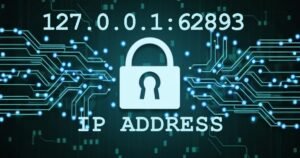Understanding the Basics of 127.0.0.1
In the realm of computer networking, the term ‘127.0.0.1’ is predominantly recognized as the localhost or loopback address. This unique IPv4 address is part of the loopback range, which is designed for a specific purpose: enabling a device to communicate with itself. When a computer sends data to this address, it is effectively performing internal networking 127.0.0.1:62893 without the involvement of an external network connection. 127.0.0.1:62893 This feature proves invaluable for developers and network engineers, as 127.0.0.1:62893 it allows them to test applications and services in a controlled environment.
The role of 127.0.0.1 is crucial in various 127.0.0.1:62893 scenarios, particularly in software development. Developers can run servers and applications locally without needing to engage with external systems or the internet. This capability not only enhances security by limiting exposure to the outside world but also accelerates the testing process by allowing immediate feedback. Moreover, using this loopback address, programmers can troubleshoot network configurations and application behaviors, ensuring their solutions function correctly before deploying them to production environments.
In terms of representation within the IPv4 address space, ‘127.0.0.1’ falls under the loopback address range, which occupies the entire 127.0.0.0/8 subnet (from 127.0.0.0 to 127.255.255.255). However, ‘127.0.0.1’ is typically the most utilized address within this range. This widespread use underscores its importance across various applications, including web servers, database 127.0.0.1:62893 connectivity, and network diagnostics. Whether developers are creating websites or testing new software functionalities, the significance of ‘127.0.0.1‘ as a reliable loopback address cannot be overstated.
The Functionality of Port 62893
In the realm of computer networking, ports serve as communication endpoints for various services and applications. Each port is designated with a unique 127.0.0.1:62893 number, allowing multiple processes to coexist on a single device while avoiding conflicts. The IP address 127.0.0.1, commonly referred to as the loopback address, is often associated with local communications within the host machine. When paired with port numbers like 62893, these addresses facilitate inter-process communication efficiently.
Port 62893, in particular, is an ephemeral port that falls within the range typically used for dynamic or private purposes. These ports are allocated temporarily to facilitate the transmission of data between applications or services without requiring a static assignment. 127.0.0.1:62893 As such, port 62893 can be linked to various applications, particularly during development or testing phases, as it provides a reliable means for developers to simulate server responses without leaving the localhost environment.
Several applications may utilize port 62893, including local web servers, development environments, and even testing frameworks designed to emulate network conditions. For instance, a web developer may configure a local server to listen on this specific port while building and testing a web application. This allows for seamless interaction between the client and server components, enabling a practical approach to troubleshooting and debugging.
Moreover, since port 62893 is 127.0.0.1:62893 often used for services that do not require high security, it can sometimes be involved in remote debugging sessions or lightweight service configurations within controlled networks. Such usage underscores the flexibility that network ports provide; they are foundational to numerous functionalities in computing and essential for modern application design. By understanding the significance of port 62893 in conjunction with the loopback address 127.0.0.1, network administrators and developers can optimize local communication and enhance their workflows effectively.
Security Implications of Using 127.0.0.1:62893
The loopback address 127.0.0.1:62893 plays a crucial role in networking, particularly in maintaining the security of local services and applications. By allowing communication within the same host, this address helps isolate applications from external threats, acting as a barrier against unauthorized access. When services are configured to listen on the loopback interface, they are shielded from incoming traffic from outside networks, mitigating the risk of attacks such as Distributed Denial of Service (DDoS) or unauthorized data exploitation.
However, while the use of 127.0.0.1:62893 provides a level of inherent security through its isolation, there are vulnerabilities to consider. Exposing internal services, even on this loopback address, may create risks if not properly managed. For instance, if developers inadvertently allow access to sensitive applications by misconfiguring firewall settings or neglecting to secure service defaults, it could lead to unauthorized exploitation of these local services. Therefore, attention must be given to ensuring that only trusted applications are allowed to communicate over this port.

To maintain security when utilizing 127.0.0.1:62893, several best practices are recommended. Firstly, developers should ensure that all local services are up to date and patched to address any known vulnerabilities. Additionally, implementing comprehensive access controls can prevent unauthorized applications from accessing these services. Further, utilizing robust authentication protocols and encryption methods for communication can enhance the security of data exchanged over the loopback address. Regularly reviewing and auditing server configurations to align with security policies will also ensure that no unintended exposure occurs.
In summary, while 127.0.0.1:62893 offers substantial protection against external threats, it is imperative to remain vigilant about potential vulnerabilities. Through meticulous configuration and proactive security measures, organizations can leverage the advantages of this loopback address while minimizing associated risks.
Practical Applications and Use Cases for 127.0.0.1:62893
The IP address 127.0.0.1, commonly referred to as localhost, is a crucial component in the realm of computing and networking. In conjunction with the port 62893, it provides a specialized environment for developers and network technicians alike. One of the primary uses of 127.0.0.1:62893 is for testing web applications. Developers often utilize this local address to mirror the environment that a production server would provide. By deploying applications on this address, they can safely test functionalities without the risk of external interference or data exposure. This method allows for quick iterations and debugging, which is invaluable in a developer’s workflow.
Another significant application of 127.0.0.1:62893 is in the operation of local development servers, which simulate web hosting environments. Tools such as XAMPP or WAMP utilize this address to create a personal server on individual machines. This gives developers the ability to run complex server-side scripts or work with database integration in a controlled setting. It is not uncommon for developers to configure their applications to listen on this specific port to maintain a consistent development environment.
Furthermore, troubleshooting networking issues is another critical application of 127.0.0.1:62893. By routing traffic to the localhost, network technicians can assess and identify issues without impacting external networks. For instance, when a network service fails, using the localhost can help isolate whether the problem lies within the local machine or an external server. Tools such as Telnet or Netcat often make use of this address to test connections and services effectively.
In conclusion, the utilization of 127.0.0.1:62893 extends across various domains including web application testing, local server operations, and troubleshooting. These practical applications not only enhance the efficiency of developers and network professionals but also provide a secure environment for exploring new projects.
May Be You Also Read

